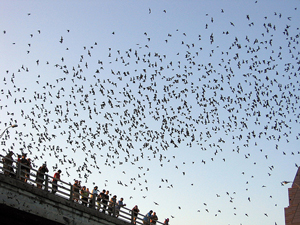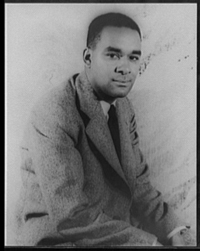
Source: Urban bats take flight from the Congress street bridge in Austin, Texas, shewhopaints, Flickr
Writers rely on carefully chosen words (diction) to get their readers to understand how they feel about a particular subject (tone). This selection of words is crucial because if the reader misunderstands the tone used by a writer, the reader will not interpret the piece correctly.
Tone also depends on the details the writer chooses to include. Read the following selection from “In Praise of Bats” by Diane Ackerman. In this excerpt, Ackerman is visiting Austin, Texas, to see the colony of Mexican free-tail bats that live under the Congress Avenue Bridge. Look especially at the words and phrases that are highlighted and think about how they add meaning or interest to the writing.
Tucked inside the crevices under the bridge were three quarters of a million bachelor free-tailed bats. They made Austin the summer home of the largest urban bat population in the world. As the sun ladled thick pastels into the river, two crew boats pulled gently, side by side. Could they see the bats when they passed under the bridge, I wondered? Sweethearts had begun to stroll across the bridge hand in hand, waiting for the emergence. Sodium lights from the Hyatt Hotel cast a trail of copper coins across the water. Suddenly, smoke billowed from underneath the bridge. No, not smoke but a column of bats. Then two columns soared high and flew in parallel, like the long black reins of an invisible sleigh. Bats kept surging out, and soon four columns stretched miles across the sky. A few strays looped and fed near us, passing like shuttles through the weaves of the trees. The night was noticeably free from insects, but that was no surprise. These bats would eat five thousand pounds of insects that one night alone.
You could use close reading strategies such as examining words and asking questions to get more meaning from this passage. See if you can determine Ackerman’s meaning, especially when she uses figurative language, or language not intended to be taken literally. To understand the Ackerman passage and other kinds of writing, again consider the questions from the introduction:
- What is your overall impression of the passage?
- What mood does the passage create in you?
- What words do you notice first in the passage?
- Do any of the words seem to be used in an interesting or odd way?
- Why did the writer choose those specific words?
- Why did the writer choose to include specific details?
Think about these questions as they relate to the Ackerman passage and answer the following questions about her choices:

1. What does the phrase “the sun ladled thick pastels into the river” mean?
2. When Ackerman says that the bats were “passing like shuttles through the weave of trees,” she is comparing the flight of the bats to which of the following?
3. Consider both the highlighted words in the passage and the details Ackerman uses to describe this experience as you complete the following statement: Ackerman’s tone when she describes the bats is one of—

Source: Bats!, Dave 77459, Flickr
To show how diction can create the writer’s tone, read the passage again (below). This time, however, some of the words and phrases have been changed to create a different tone. As you read the passage, click on the word choices that change the tone of the passage from one of wonder to one of darkness and dread. You should find nine instances where words or phrases have been revised. If you choose correctly, the word or phrase will highlight.

After completing this exercise, you can probably see how important diction is in creating the writer’s tone. Close reading and paying attention to the author’s diction can greatly aid your understanding of a piece. Examining a writer’s word choices will help you understand how the writer thinks or feels about a particular subject.
Next you will read an excerpt from Richard Wright’s autobiography Black Boy. In the pages leading up to this passage, Wright attends a church service with his grandmother and walks out feeling emotionally uplifted until reality hits. Read the paragraph below, but as you read, click on the words that help create tone. You should find at least 11 words or phrases. If you choose correctly, the words will highlight.


Source: Portrait of Richard Wright, Carl Van Vechten, Library of Congress
After reading the passage and highlighting the words and phrases that create Richard Wright’s tone, click on one word in the list below that describes what the writer feels in this excerpt.
Reading closely and noting a writer’s diction to understand tone is always necessary. If you misunderstand tone, you won’t interpret a piece of writing correctly.